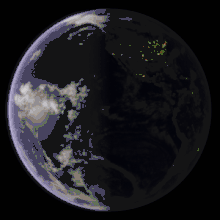Diurnal cycle
A diurnal cycle is any pattern that recurs every 24 hours as a result of one full rotation of the Earth[1] around its own axis.

In climatology, the diurnal cycle is one of the most basic forms of climate patterns. The most familiar such pattern is the diurnal temperature variation. Such a cycle may be approximately sinusoidal, or include components of a truncated sinusoid (due to the Sun's rising and setting) and thermal relaxation (Newton cooling) at night.
Diurnal cycles of environmental conditions (light or temperature) can result in similar cycles in dependent biological processes, such as photosynthesis in plants,[2] or clinical depression in humans.[3] Plant responses to environmental cycles may even induce indirect cycles in rhizosphere microbial activities, including nitrogen fixation.[4]
A semi-diurnal cycle refers to a pattern that occurs about every twelve hours or about twice a day. Often these can be related to lunar tides, in which case the interval is closer to 12 hours and 25 minutes.
References
- http://en.mimi.hu/meteorology/diurnal_cycle.html
- Xu, D. and Shen, Y. 2005. External and internal factors responsible for midday depression of photosynthesis. P 287-297. In Pessarakli, M. (ed). Handbook of Photosynthesis (2nd ed.). Taylor and Francis Group, LLC. Boca Raton, Florida, USA.
- Wirz-Justice, A. 2008. Diurnal variation of depressive symptoms. Dialogues in Clinical Neuroscience . 10(3): 337-343.
- Sims, G. K. and Dunigan, E. P. 1984 Diurnal and seasonal variations in nitrogenase activity (C2H2 reduction) of rice roots. Soil Biology and Biochemistry. 16:15-18.